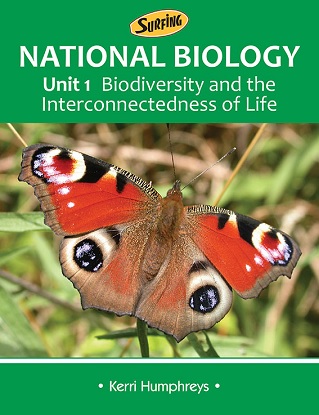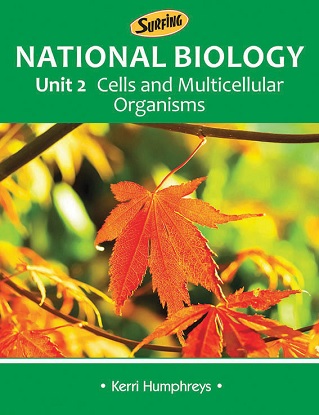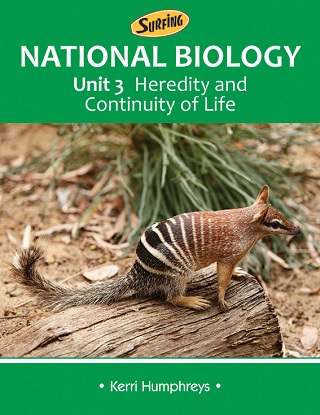National Surfing Biology Unit 4
- Kerri Humphreys
- Science Press
- 2016
- ISBN: 9780855836825
RRP: $49.95 (Inc. GST)

Description
Each book in the Surfing series contains a summary, with occasional more detailed sections, of all the mandatory sections of the syllabus, along with questions and answers.
All types of questions – multiple choice, short response, structured response and free response – are provided.
Questions are written in exam style so that you will become familiar with the concepts of the topic and answering questions in the required way.
Answers to all questions are included.
A topic test at the end of the book contains an extensive set of summary questions, including multiple choice and free response questions. These cover every aspect of the topic, and are useful for revision and exam practice. Marking guidelines are supplied where appropriate.
Table of Contents
Introduction
Words to Watch
Homeostasis
1 Assumed Knowledge
2 Homeostasis
3 The Role of the Nervous System
4 The Stimulus-Response Model
5 Reflexes
6 Receptors
7 Feedback Mechanisms
8 Homeostasis and Temperature Control
9 Modelling Human Thermoregulation
10 Homeostasis and Blood Composition
11 Changing Metabolic Activity
12 Activity – Carbon Dioxide Needs to be Excreted
13 The Hypothalamus and Homeostasis
14 Body Structures Aid Homeostasis
15 Behaviour and Homeostasis
16 Homeostasis, Excretion and Osmoregulation
17 Osmoreceptors and Water Balance
18 Renal Dialysis
19 Structure of a Neuron
20 The Action Potential
21 Crossing the Synapse
22 Types of Neurotransmitters
23 Transmission of a Nervous Impulse
24 The Endocrine System and Hormones
25 Three Steps in Signal Transduction
26 Comparing the Endocrine System and Nervous System
27 The Pituitary Gland
28 The Thyroid Gland
29 The Adrenal Glands
30 The Pancreas
31 Play – Keeping Up With the Hormones
32 Hormones and Feedback Regulation
33 Hormones and the Dairy Industry
34 Snake Antivenom Production
35 Plant Hormones
36 Experiments – Hormones and Phototropism
37 Australian Endotherms and Ectotherms and Temperature Control
38 Plants and Temperature Change
39 Plants and Water Loss
40 Mangroves and Enantiostasis
41 Estuaries
42 Experiment – Structures in Plants for Water Conservation
Infectious Disease
43 Infectious Disease
44 Non-Infectious Disease
45 Health, Disease and Cleanliness
46 Gene Expression and Maintaining Health
47 Apoptosis
48 Malfunctions in Apoptosis
49 Experiment – Microbes in Food and Water
50 Water Treatment
51 Louis Pasteur
52 Robert Koch
53 Pathogen Transmission
54 Prion Pathogens
55 Case Study – Creutzfeldt-Jakob Disease
56 Virus Pathogens
57 Case Study – Human Immunodeficiency Virus
58 Bacteria Pathogens
59 Case Study – Cholera
60 Antibiotics and Bacterial Infections
61 Protist Pathogens
62 Case Study – Cryptosporidium
63 Fungi Pathogens
64 Case Study – Tinea
65 Macroparasites
66 Case Study – Pork Tapeworm
67 Disease with an Insect Vector – Malaria
68 Plant Pathogens
69 Plant Bacteria and Insect Pests
70 Australian Quarantine
71 Barriers – The First Line of Defence
72 Antigens
73 The Immune Response – The Second Line of Defence
74 Play – Inside the Immune System
75 Leucocytes
76 Mast Cells and Dendritic Cells
77 Complement Proteins
78 The Inflammatory Response
79 The Lymphatic System
80 The Third Line of Defence
81 B Lymphocytes
82 The Structure of Antibodies
83 T Lymphocytes
84 Macfarlane Burnet
85 Immunity
86 Vaccination Programs
87 Epidemiology
88 Pandemics – Influenza
89 Modelling Disease Outbreak and Spread
90 Managing Pandemics in the Asia Region
91 Immune Deficiency Diseases
92 Autoimmune Diseases
93 Allergic Reactions
94 Epidemiology and the Cause of Lung Cancer
95 Monoclonal Antibodies and Cancer
96 Strategies to Control the Spread of Disease
97 Rational Drug Design
98 Antiviral Drugs and Antiobiotics
Topic Test
Answers
Index





